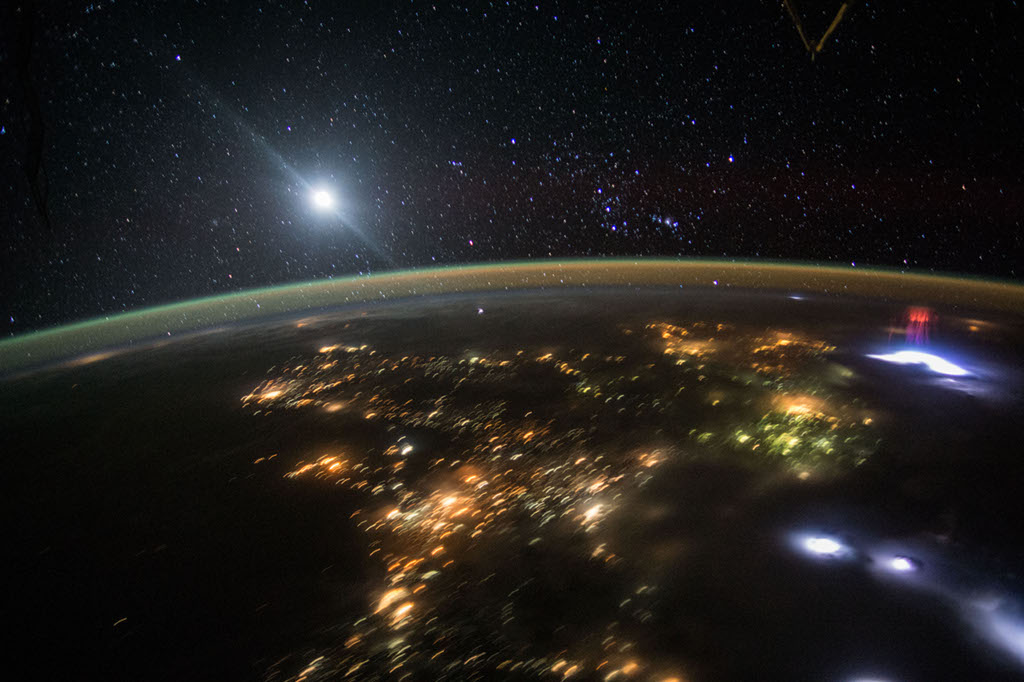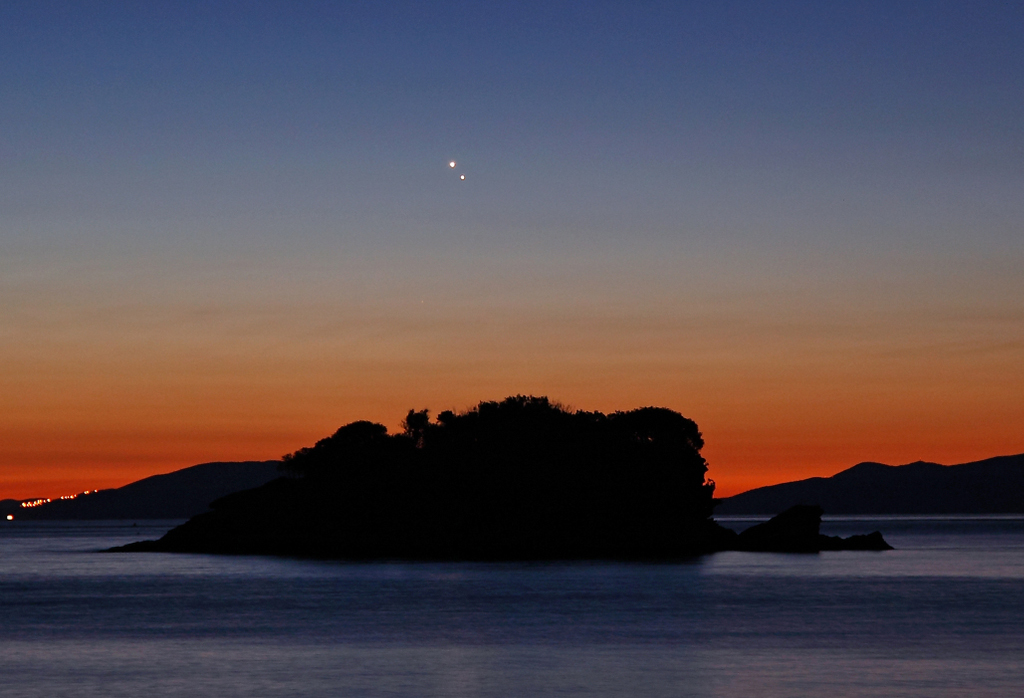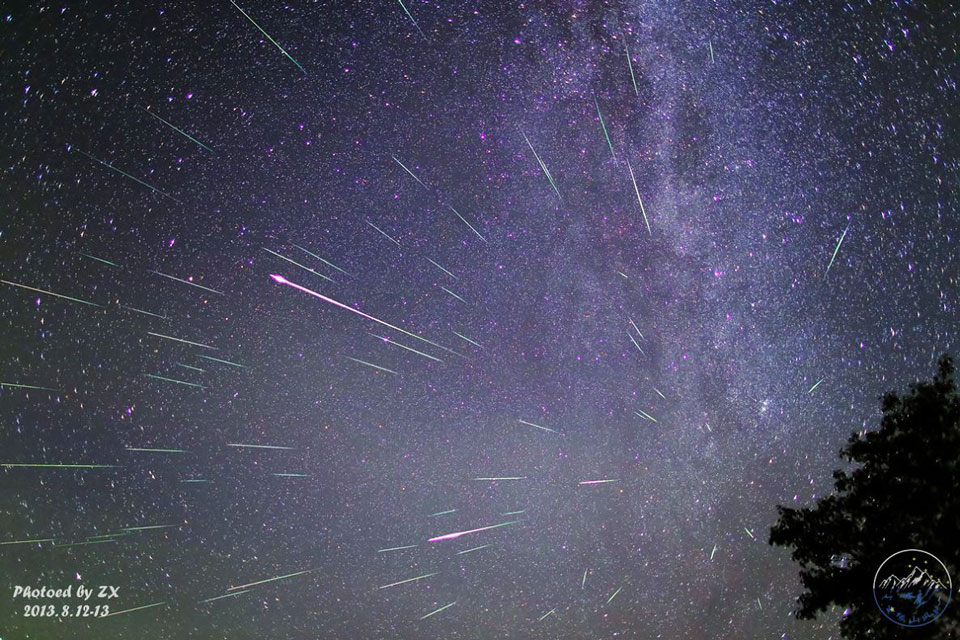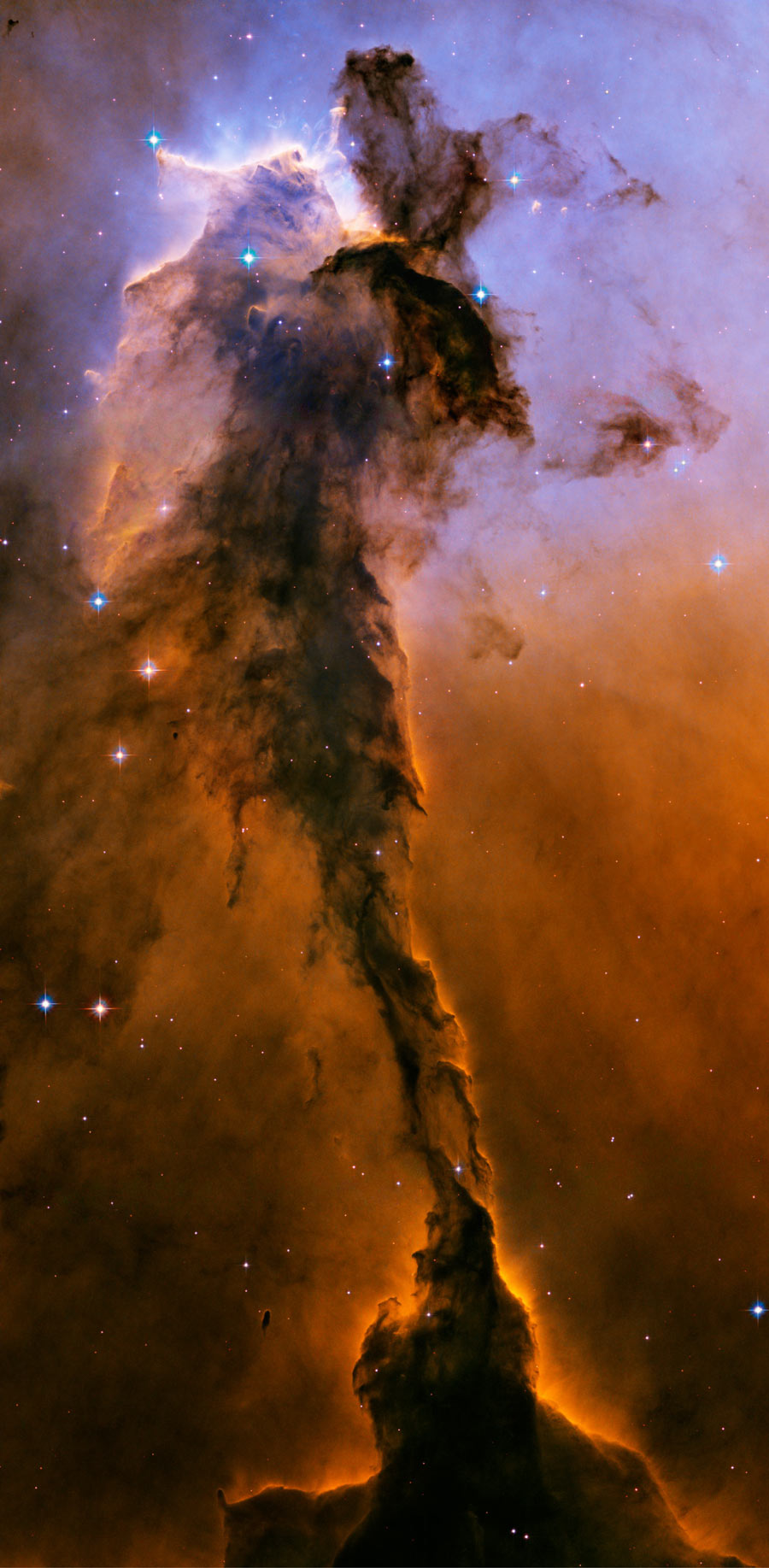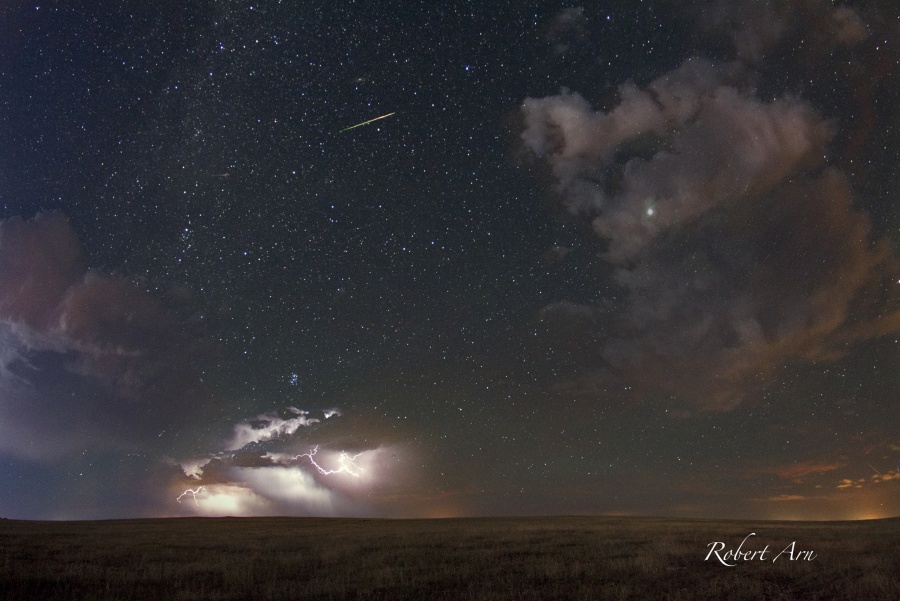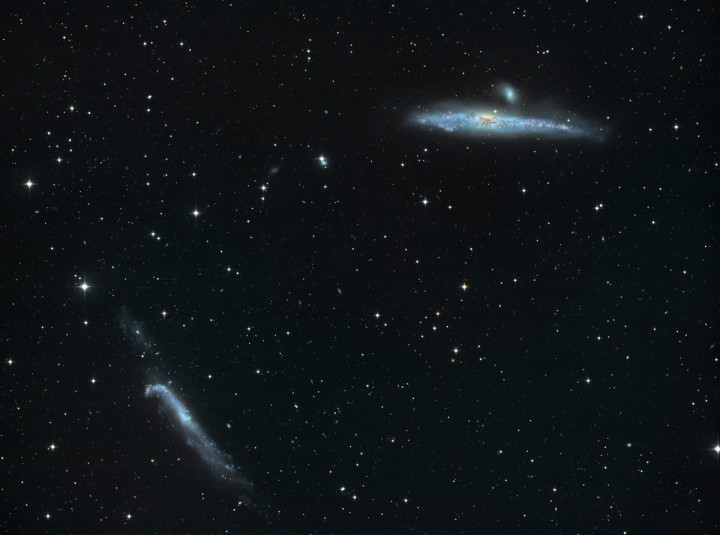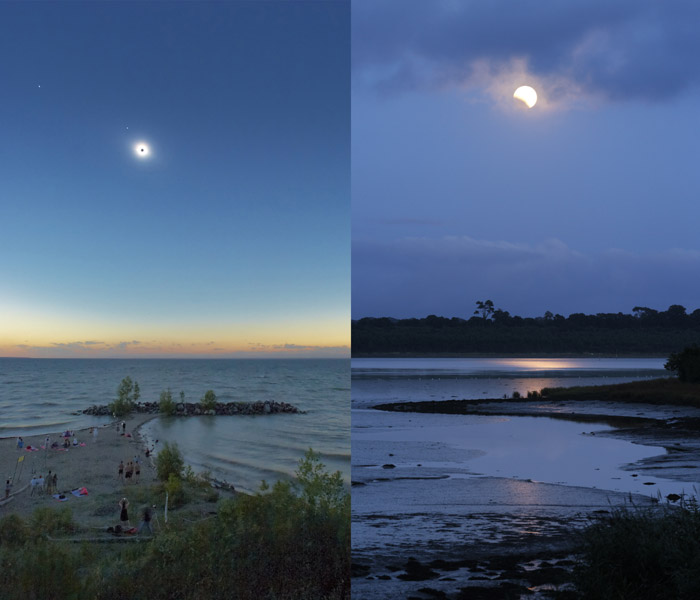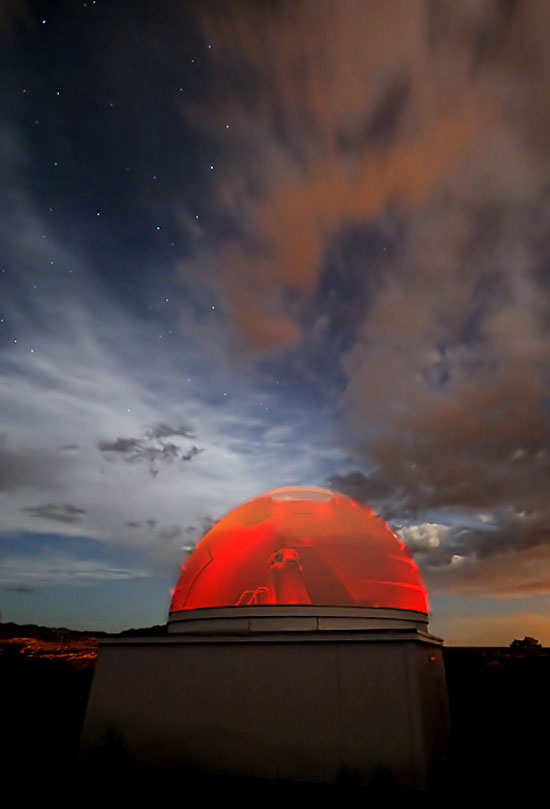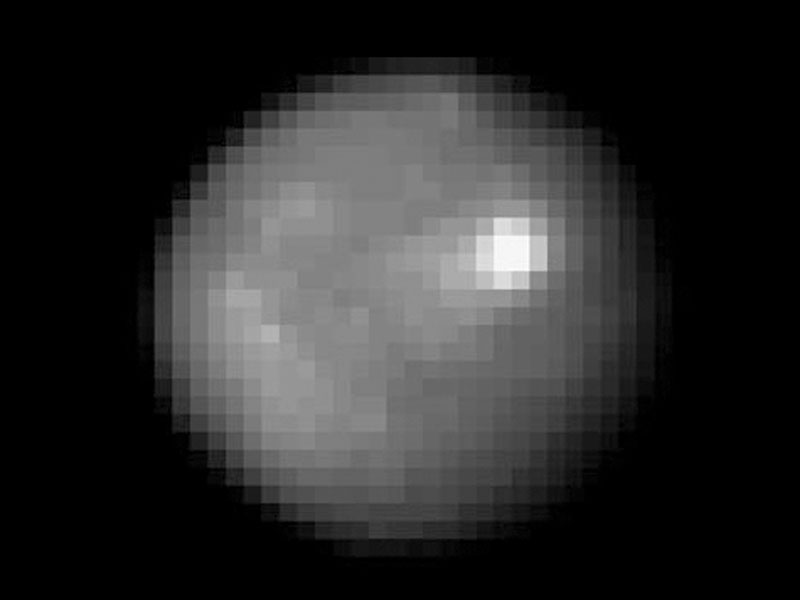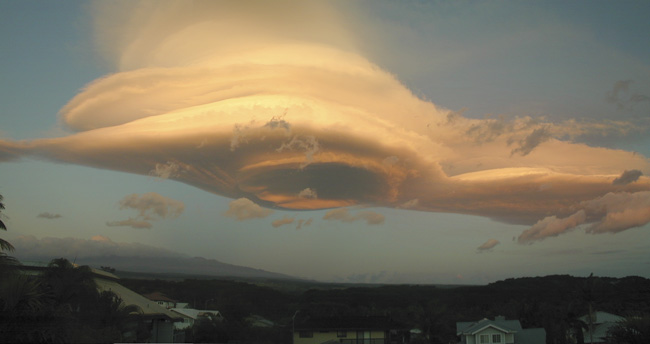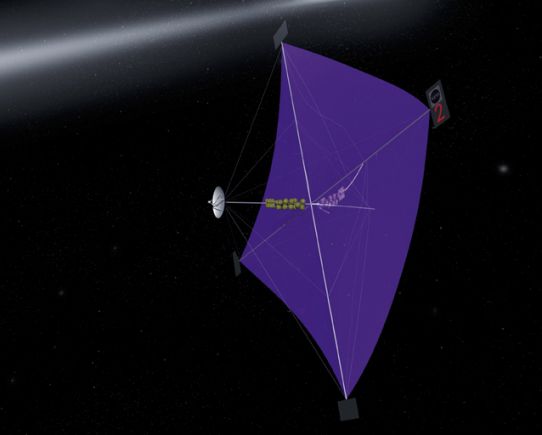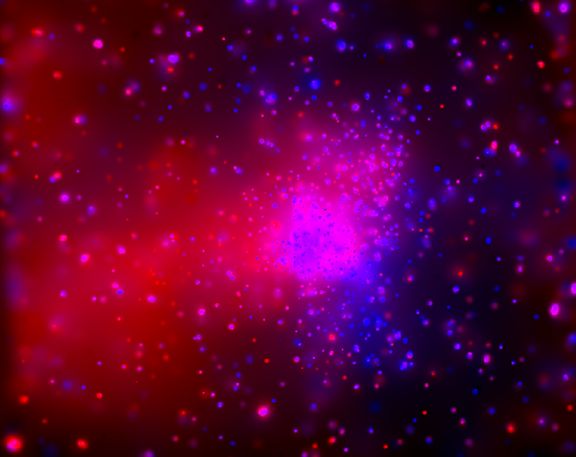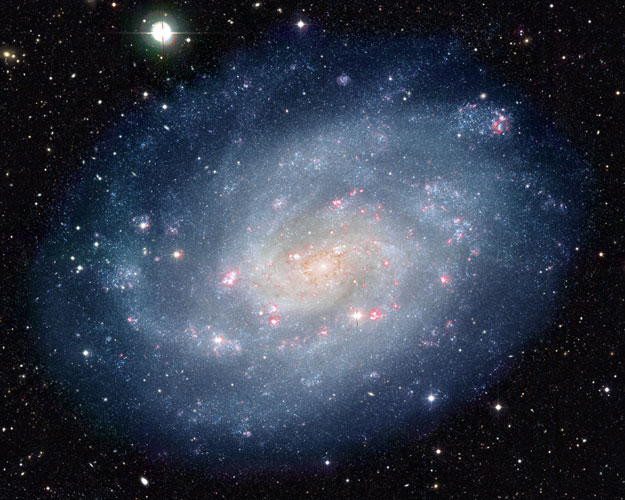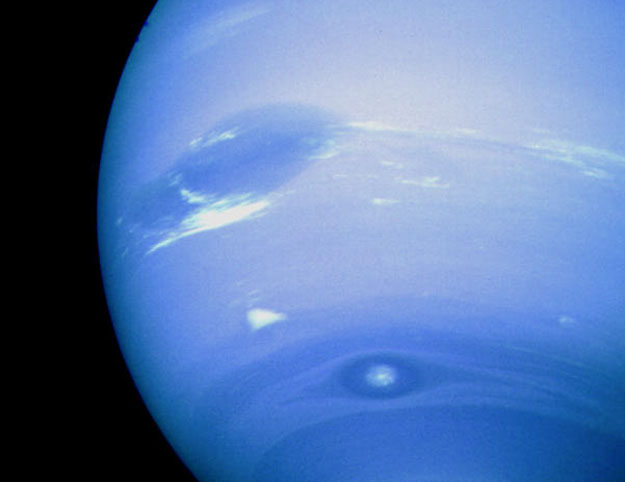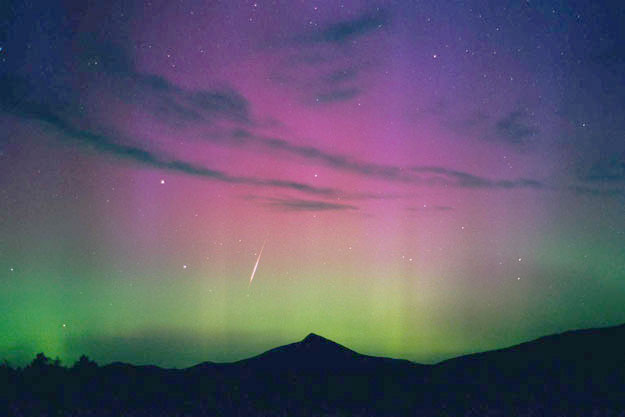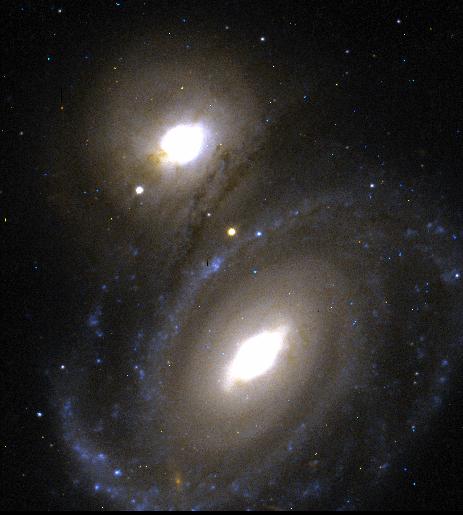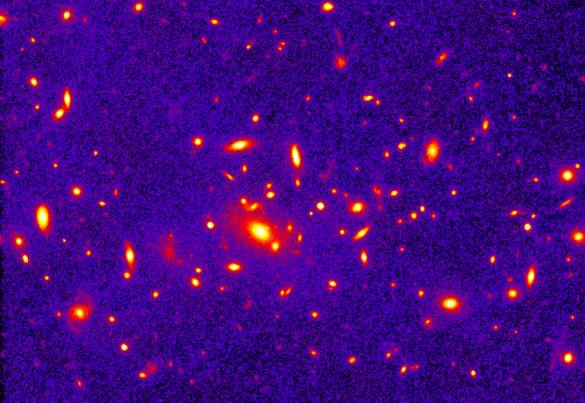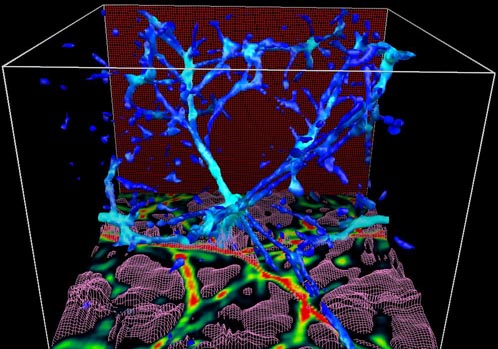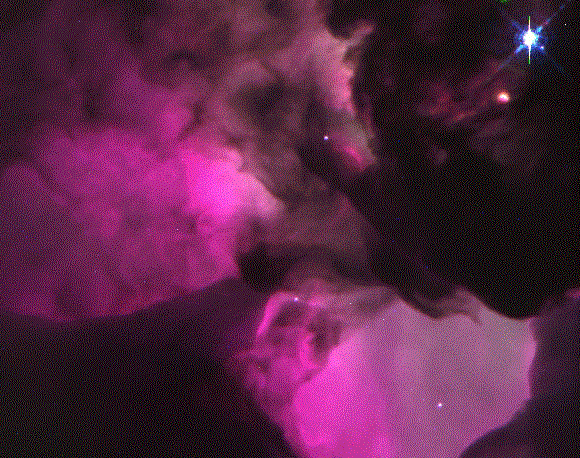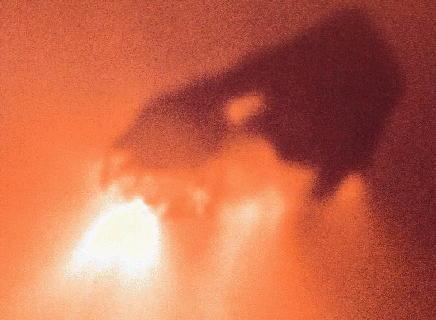| << Previous | Index | Next >> |
2015 An old Moon and the stars of Orion rose above the eastern horizon on August 10. The Moon's waning crescent was still bright enough to be overexposed in this snapshot taken from another large satellite of planet Earth, the International Space Station. A greenish airglow traces the atmosphere above the limb of the planet's night. Below, city lights and lightning flashes from thunderstorms appear over southern Mexico. The snapshot also captures the startling apparition of a rare form of upper atmospheric lightning, a large red sprite caught above a lightning flash at the far right. While the space station's orbital motion causes the city lights to blur and trail during the exposure, the extremely brief flash of the red sprite is sharp. Now known to be associated with thunderstorms, much remains a mystery about sprites including how they occur, their effect on the atmospheric global electric circuit, and if they are somehow related to other upper atmospheric lightning phenomena such as blue jets or terrestrial gamma flashes.
2014 On Monday morning, Venus and Jupiter gathered close in dawn skies, for some separated by about half the width of a full moon. It was their closest conjunction since 2000, captured here above the eastern horizon before sunrise. The serene and colorful view is from Istia beach near the city of Capoliveri on the island of Elba. Distant lights and rolling hills are along Italy's Tuscan coast. Of course, the celestial pair soon wandered apart. Brighter Venus headed lower, toward the eastern horizon and the glare of the Sun, while Jupiter continues to rise a little higher now in the sky near dawn. The two brightest planets meet again next June 30th, in the evening twilight above the western horizon.
2013 Comet dust rained down on planet Earth earlier this month, streaking through dark skies in the annual Perseid meteor shower. While enjoying the anticipated space weather above Zhangbei Prairie, Hebei Province, China, astronomer Xiang Zhan recorded a series of 10 second long exposures spanning four hours on the night of August 12/13 using a wide angle lens. Combining frames which captured 68 meteor flashes, he produced the above composite view of the Perseids of summer. Although the sand-sized comet particles are traveling parallel to each other, the resulting shower meteors clearly seem to radiate from a single point on the sky in the eponymous constellation Perseus. The radiant effect is due to perspective, as the parallel tracks appear to converge at a distance. The next notable meteor shower may be the Orionids in late October.
2012
Click to play embedded YouTube video.
Animation Credit & Copyright: Drew Berry, WEHI, HHMI, DNALC
2011 The dust sculptures of the Eagle Nebula are evaporating. As powerful starlight whittles away these cool cosmic mountains, the statuesque pillars that remain might be imagined as mythical beasts. Pictured above is one of several striking dust pillars of the Eagle Nebula that might be described as a gigantic alien fairy. This fairy, however, is ten light years tall and spews radiation much hotter than common fire. The greater Eagle Nebula, M16, is actually a giant evaporating shell of gas and dust inside of which is a growing cavity filled with a spectacular stellar nursery currently forming an open cluster of stars. The above image in scientifically re-assigned colors was released in 2005 as part of the fifteenth anniversary celebration of the launch of the Hubble Space Telescope.
2010 Storms on the distant horizon and comet dust raining through the heavens above are combined in this alluring nightscape. The scene was recorded in the early hours of August 13 from the Keota Star Party site on the Pawnee National Grasslands of northeastern Colorado, USA. Looking east across the prairie, the composite of 8 consecutive exposures each 30 seconds long captures the flash of lightning and a bright Perseid meteor. On the right, even the clouds can't block the light from brilliant planet Jupiter, whose mythological namesake knew how to handle both lightning bolts and meteors. Of course, this meteor's streak points back toward the shower's radiant in the heroic constellation Perseus, sharing a starry background that includes the Pleiades star cluster poised above the storm clouds. Just above the bright meteor lies the faint Andromeda Galaxy.
2009 NGC 4631 is a big beautiful spiral galaxy seen edge-on (top right) only 25 million light-years away towards the small northern constellation Canes Venatici. This galaxy's slightly distorted wedge shape suggests to some a cosmic herring and to others the popular moniker of The Whale Galaxy. Either way, it is similar in size to our own Milky Way. In this gorgeous color image, the Whale's dark interstellar dust clouds, yellowish core, and young blue star clusters are easy to spot. A companion galaxy, the small elliptical NGC 4627, appears above the Whale Galaxy. At the lower left is another distorted galaxy, the hockey stick-shaped NGC 4656. The distortions and mingling trails of gas detected at other wavelengths suggest that all three galaxies have had close encounters with each other in their past. The Whale Galaxy is also known to have spouted a halo of hot gas glowing in x-rays.
2008 This August was eclipse season. The month's first New Moon and Full Moon were both seen in darkened skies during a solar and lunar eclipse. Blocking the Sun, the left panel's New Moon was captured during the total solar eclipse of August 1 from the path of totality overlooking Novosibirsk (Siberia) Reservoir, locally known as the Ob Sea. A lovely solar corona and bright inner planets Mercury and Venus emerged during the total eclipse phase, while the flickering view screens of eclipse watchers' digital cameras dotted the landscape. On the right, the Full Moon grazed Earth's shadow nearly 15 days later in a partial lunar eclipse. That serene view was recorded during an early evening stroll along the shores of the Odet River near the city of Quimper in western France. For planet Earth there are about two seasons each year during which the orientation of the Moon's orbit is favorable for solar and lunar eclipses. The next eclipse season begins in January 2009 with an annular solar eclipse.
2007 Why would the dome of a telescopic observatory appear translucent red? As one of the telescopes of the Etscorn Observatory of New Mexico Tech waited to inspect small portions of the night sky, playful observers decided to make this unusual image. Tricks needed to create this seemingly impossible shot included opening the observatory dome slightly, using a red light to illuminate the inside of the dome, spinning the dome, and using a long exposure. The open slit in the dome then allowed the camera to incrementally image the inside of the observatory, including the telescope. A fortuitous break in the clouds allowed the stars of the Big Dipper asterism to shine through.
2006 Is Ceres an asteroid or a planet? Although a trivial designation to some, the recent suggestion by the Planet Definition Committee of the International Astronomical Union would have Ceres reclassified from asteroid to planet. A change in taxonomy might lead to more notoriety for the frequently overlooked world. Ceres, at about 1000 kilometers across, is the largest object in the main asteroid belt between Mars and Jupiter. Under the newly proposed criteria, Ceres would qualify as a planet because it is nearly spherical and sufficiently distant from other planets. Pictured above is the best picture yet of Ceres, taken by the Hubble Space Telescope as part of a series of exposures ending in 2004 January. Currently, NASA's Dawn mission is scheduled to launch in 2007 June to explore Ceres and Vesta, regardless of their future designations.
2005 Can a cloud do that? Actually, pictured above are several clouds all stacked up into one striking lenticular cloud. Normally, air moves much more horizontally than it does vertically. Sometimes, however, such as when wind comes off of a mountain or a hill, relatively strong vertical oscillations take place as the air stabilizes. The dry air at the top of an oscillation may be quite stratified in moisture content, and hence forms clouds at each layer where the air saturates with moisture. The result can be a lenticular cloud with a strongly layered appearance. The above picture was taken near Mauna Kea, Hawaii, USA.
2004 Could solar sailing become a future Olympic sport? Nearly 400 years ago astronomer Johannes Kepler observed comet tails blown by a solar breeze and suggested that vessels might likewise navigate through space using appropriately fashioned sails. It is now widely recognized that sunlight does indeed produce a force which moves comet tails and a large, reflective sail could be a practical means of propelling a spacecraft. In fact, the illustration above represents a concept explored by NASA for an interstellar probe pushed along by sunlight reflected from an ultrathin sail. Nearly half a kilometer wide, the delicate solar sail would be unfurled in space. Continuous pressure from sunlight would ultimately accelerate the craft to speeds about five times higher than possible with conventional rockets. While not quite ready for the Olympics, NASA has recently tested solar sail technologies on earth and the Japanese Space Agency ISAS has deployed solar sail material in space. The Planetary Society in collaboration with the Space Research Institute (IKI) in Moscow and partners is preparing to launch Cosmos 1, a solar sail powered spacecraft.
2003 About 5,000 light-years away, toward the constellation Sagittarius and the center of our galaxy, lies the bright star forming region cataloged as M17. In visible light, M17's bowed and hollowed-out appearance has resulted in many popular names like the Horseshoe, Swan, Omega, and Lobster nebula. But what has sculpted this glowing gas cloud? This Chandra Observatory image of x-rays from M17 provides a clue. Many massive young stars are responsible for the pink central region of the false-color x-ray picture, their colliding stellar winds producing the multimillion degree gas cloud which extends ten or so light-years to the left. When compared with visible light images, this x-ray hot cloud is partly surrounded by the nebula's cooler gas. In fact, having carved out a central cavity the hot gas seems to be flowing out of the horseshoe shape like champagne from an uncorked bottle ... suggesting yet another name for star forming region M17.
2002 NGC 300 is so interesting because it is so normal. An Sc-type spiral galaxy in the nearby Sculptor group of galaxies, NGC 300 shows typical flowing blue spiral arms, an expected compact nucleus, and the requisite amount of stars, star clusters, and nebulae. Therefore, studying NGC 300 should indicate how, exactly, a normal spiral galaxy works. Toward this goal, NGC 300 and the surrounding area were studied in exquisite detail, creating and combining a series of high-resolution images to create the above conglomerate picture. NGC 300 lies only 7 million light years away, spans nearly the same amount of sky as the full moon, and is visible with a small telescope toward the constellation of Sculptor.
2001 Neptune has spots. The Solar System's outermost gas giant shows a nearly uniform blue hue created by small amounts of methane drifting in a thick atmosphere of nearly colorless hydrogen and helium. Dark spots do appear, however, that are anti-cyclones: large high-pressure systems that swirl in Neptune's cold cloud tops. Two dark spots are visible in the above picture taken by the robot Voyager 2 spacecraft in 1989: an Earth-sized Great Dark Spot located on the far left, and Dark Spot 2 located near bottom. A bright cloud dubbed Scooter accompanies the Great Dark Spot. Recent computer simulations indicate that scooters are methane clouds that might commonly be found near dark spots. Subsequent images of Neptune by the Hubble Space Telescope in 1994 indicated that both of these dark spots had dissipated, but another had been created.
2000 Just after the Moon set but before the Sun rose in the early morning hours of August 12, meteors pelted the Earth from the direction of the constellation Perseus, while ions pelted the Earth from the Sun. The meteors were expected as sub-sand grains long left behind by Comet Swift-Tuttle annually create the Perseids Meteor Shower. The aurorae were unexpected, however, as electrons, protons, and heavier ions raced out from a large Coronal Mass Ejection that had occurred just days before on the Sun. In the foreground is Hahn's Peak, an extinct volcano in Colorado, USA.
1999 This striking pair of galaxies is far, far away ... about 350 million light-years from Earth. Cataloged as AM0500-620, the pair is located in the southern constellation Dorado. The background elliptical and foreground spiral galaxy are representative of two of the three major classes of galaxies which inhabit our Universe. Within the disks of spiral galaxies, like our own Milky Way, gas, dust, and young blue star clusters trace out grand spiral "arms". The dust lanes along the arms of this particular spiral stand out dramatically in this Hubble Space Telescope image as they obligingly sweep in front of the background elliptical. Like the central bulges of spiral galaxies, elliptical galaxies tend toward spherical shapes resulting from more random motions of their stars. But while spirals produce new stars, star formation in ellipticals which lack gas and dust seems to have stopped. How do galaxies evolve with cosmic time? Evidence is growing that graceful galaxy shapes can hide a violent history.
1998 Conventional theories suggest that this cluster of galaxies should not exist. Each fuzzy spot in this false-color Hubble Space Telescope image of the central regions of a newly discovered galaxy cluster is a galaxy similar in mass to our own Milky Way. The cluster is one of the most massive known, contains thousands of galaxies, and is a few million light-years across. But it is also 8 billion light-years distant and so formed when the Universe was only about half its present age. Ironically, if the total mass of the Universe is large, modern theories predict that clusters of galaxies as massive as nearby clusters should not have existed at such early times and great distances. One explanation for this cluster's presence is that the Universe we live in is not massive enough to eventually halt its expansion - contradicting some current standard views of cosmology.
1997 Is this our universe? Possibly. It is one computerized guess of how gas in the universe was distributed billions of years ago, at redshift 3, when the universe was only a quarter of its present age. Using supercomputers at the National Center for Supercomputing Applications and assumptions about the composition and beginning of the universe, the GC3 team was able to reconstruct a hypothetical universe. A cube of this universe was cut out and displayed, with each side being about 8 million light years across. Color represents temperature of the hot gas. At the bottom a single slice through this cube is displayed, with helium abundance superposed with a wire mesh. The small structures appearing here give insight into the past and present structure of the intergalactic medium, the matter inhabiting the regions between galaxies and clusters of galaxies.
1996 In the central part of the Lagoon Nebula lies the above pictured Hourglass Nebula. In this region of recent star formation, obscuring dark lanes of dust permeate the red-glowing hydrogen gas. Blocking some of the gas cloud from our view, they chance to create a glowing shape that appears from our vantage point like an hourglass. In the upper right of this picture from the Hubble Space Telescope is a bright young blue star from the open cluster NGC 6530 - visible below center in yesterday's APOD. A recent study of the Lagoon Nebula (M8), has shown that this emission nebula houses large magnetic fields and unusually large dust particles.
1995 A comet nucleus, formed from the primordial stuff of the solar system, resembles a very dirty iceberg. Orbiting far from our Sun, it can remain frozen, preserved for billions of years. Occasionally, a chance gravitational encounter will alter this distant orbit and send the nucleus plummeting towards the inner solar system. In 1986, the European spacecraft Giotto visited the nucleus of Halley's comet as it approached the sun. Data from Giotto's cameras were used to produce this enhanced image which shows surface features on the dark nucleus against the bright background of clouds of gasses produced as the icy material was vaporized by the Sun's heat. The potato shaped nucleus measures about 10 miles across.
| << Previous | Index | Next >> |
